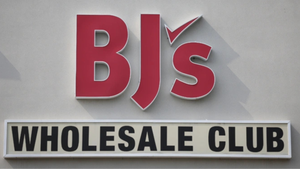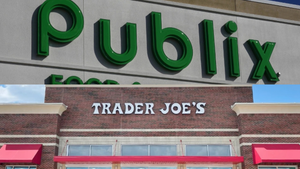Letup in grocery price inflation continues in January
Monthly and annual growth decreases amid softer gains in Consumer Price Index.

Grocery prices were down year over year in January as the Consumer Price Index (CPI) showed a dip in overall inflation.
On an annual basis, the January CPI for All Urban Consumers rose 6.4% (unadjusted), down from a 12-month uptick of 6.5% in December, the U.S. Bureau of Labor Statistics (BLS) reported Tuesday. As in the previous month, the January figure marked the lowest yearly gain since October 2021, BLS said. That compared with year-to-year growth in 2022 of 7.1% for November, 7.7% for October, 8.2% for September, 8.3% for August, 8.5% for July, 9.1% for June, 8.6% for May, 8.3% for April, 8.5% for March, 7.9% for February and 7.5% for January 2022.
The January CPI, however, edged up 0.5% (seasonally adjusted) month to month, versus a 0.1% gain in December, which represented the only decline in 2022. Save for flat growth in July, the December decrease followed increases of 0.2% in November, 0.5% in October and 0.4% in September, 0.2% in August, 1.3% in June, 1% in May, 0.3% in April, 1.2% in March, 0.8% in February and 0.6% in January 2022.
BLS noted that January 2023 CPI data include updated annual weights based on a single calendar year of data, using consumer spending data from 2021, reflecting a change from previous practice of updating weights biennially using two years of expenditure data.
Over 12 months, the food CPI—including food-at-home and food-away-from-home—eased up to 10.1% growth in January, down from 10.4% in December and 10.6% in November. Still, year-over-year food inflation has stayed in double digits since early this year despite recent decreases from 10.9% in October, 11.2% in September and 11.4% in August. Those followed a steady rise to 10.9% in July, 10.4% in June, 10.1% in May, 9.4% in April, 8.8% in March, 7.9% in February and 7% in January 2022.

Source: U.S. Bureau of Labor Statistics
Sequentially, the food index was up 0.5% in January, following a decline to 0.3% month-over-month growth in December from 0.5% in November, according to BLS. The food CPI, though, remains down from monthly upticks of 0.6% in October, 0.8% in September and August, 1.1% in July, 1% in June, 1.2% in May, 0.9% in April, 1% in March, 1% in February, and 0.9% in January 2022.
The food-at-home CPI for January indicated an 11.3% year-over-year gain, down from 11.8% in December and 12% in November. While grocery inflation remains elevated, the recent downward trend continued from 12.4% in October, 13% in September and 13.5% in August. Those two months had marked the end of increasing 12-month growth since the start of 2022, as the food-at-home index rose 13.1% for July, 12.2% for June, 11.9% for May, 10.8% for April, 10% for March, 8.6% for February and 7.4% for January.
Month-to-month, the food-at-home CPI grew 0.4% in January compared with a revised 0.5% uptick for December, which was down from 0.6% in November and signaled smallest monthly increase since December 2021 (0.4%). The 0.5% uptick for October represented a decline from 0.7% in September and 0.8% in August, when the monthly gain was the first below 1% since April. That compared with hikes of 1.3% in July, 1% in June, 1.4% in May, 0.9% in April, 1.5% in March, 1.4% in February and 1% in January 2022.
Four of the six major grocery store food group indices for food-at-home rose on a monthly basis (adjusted) in January. The cereals and bakery products index gained 1%, while the meat, poultry, fish and eggs and the other food-at-home indices were up 0.7%. Inflation ticked up 0.4% for nonalcoholic beverages 0.4%. Fruit and vegetables was the only segment showing decreased inflation (-0.5%), and dairy and related products were flat.
All six food-at-home group indices continued to be elevated in January on an annual basis (unadjusted). The sharpest 12-month price increases came from cereals and bakery products ( 15.6%), dairy and related products ( 14%), other food at home ( 13.2%) and nonalcoholic beverages ( 13.1%). Growth in inflation remained below double digits for meat, poultry, fish and eggs ( 8.1%) and fruit and vegetables ( 7.2%).
For consumers, the pricing of eggs remains a problem at grocery stores and other grocery retailers amid ongoing shortages, mainly due to widespread avian flu. Egg prices were up by 70.1% year over year (unadjusted) and by 8.5% month over month (adjusted), with the latter showing a slight letup from December.
Meanwhile, the food-away-from-home index was up 8.2% year over year for January, down from gains of 8.3% for December and 8.5% for November. Food-away-from-home also rose 0.6% sequentially in January, compared with month-over-month increases of 0.4% in December and 0.5% in November.

Source: U.S. Bureau of Labor Statistics
“The January CPI illustrates that inflationary price increases are not resetting as quickly, or as uniformly, as consumers would like,” Andy Harig, vice president of tax, trade, sustainability and policy development at FMI-The Food Industry Association, said in an emailed comment. “Unfortunately, it is likely that food prices will remain elevated in the short term, and we anticipate that there could be further volatility in terms of inflation rising and falling in the coming months. Yet we continue to remain cautiously optimistic that the worst of food price inflation is behind us.”
Backing out food and energy, the January CPI rose by 5.6% from a year ago and by 0.4% from a month ago, essentially the same as upticks of 5.7% year over year and 0.4% month to month in December, BLS reported.
Gasoline costs are down, but fuel oil remains a key factor behind elevated inflation, up 27.7% year over year (unadjusted) and down 1.2% month to month for January, compared with an annual gain of 7.3% and a monthly decline of 16.6% in December in revised data from BLS. Gas prices ticked up 2.4% on a monthly basis and were up 1.5% annually in January, compared with decreases of 7% monthly and 1.5% annually for December.
Food retailers are working to “do everything possible to keep costs down for consumers,” according to Harig. On average, shoppers are spending $151 per week on groceries, below the pandemic peak of $161 despite elevated inflation over the past year, he noted.
“To help consumers stretch their food dollar, grocers have dramatically increased investment in their store-brand offerings, among other strategies,” according to Harig. “Even as the inflationary outlook remains uncertain, retailers will continue to invest in ways to help shoppers save and work to ensure prices stay as low and as stable as possible so that customers can most effectively manage their grocery budgets.”
According to Numerator’s latest Inflation Price Pulse tracker, for the four weeks ended Jan. 22, grocery prices were 12% year over year, down from recent weeks. The consumer market data specialist said health and beauty price increases have slowed but were up 4.8% from a year ago, while pricing for household items for the period was up 14.4%.
Among retail channels over the four weeks through Jan. 22, grocery pricing was highest in the dollar store ( 19% year over year) segment, followed by mass merchants and grocery stores (both 11.4% year over year), warehouse clubs ( 8.5%) and online ( 6.7%).

Source: Numerator
“Since February 2022, the dollar channel has seen the highest rate of inflation among tracked channels,” Numerator stated. “The club channel has seen the lowest levels of grocery inflation overall throughout the year, but online is now slowing down the most as it laps over record highs in 2021.”
Despite recent signs of relaxed inflation, consumer prices in general remain high, and shoppers have adjusted their spending behavior. Of 11,000-plus consumers polled last month by shopper rewards platform Shopkick, 83% said concerns about the nation’s economy have impacted their shopping habits, and 47% plan to spend less overall in the next three months.
Still-high grocery prices are a particular consumer concern, Shopkick found. In turn, 73% of those polled said they’re using shopping reward apps and coupons more often, and 49% are making fewer trips to the store to save on gas. Thirty-one percent reported they’re shopping in bulk to save. Also, 29% are using store-specific credit cards, and 19% are opting for canned foods over fresh.
“Consumers are getting mixed messages around where the economy is headed, but they continue to be extremely wary of overspending and diligent about finding ways to save,” Brittany Billings, executive vice president of strategic markets and marketing at Shopkick, said in a statement.
The focus on groceries reflects consumers’ concern over pricing and availability of essential items, including personal care and medications. Shopkick said 55% have noticed staple items—such as eggs—less available now than they were last month. In addition, 97% of consumers report seeing price increases on everyday items over the past year. Likewise, 91% of respondents have noticed a recent uptick in gas prices after a stretch of declined pricing at the pump. As a result, 75% are cutting down on their driving.
To save, shoppers are focusing on finding sales (47%), buying more generic brands (21%), using shopping and coupon apps to find deals (18%) and spending less overall (12%), Shopkick’s survey showed.
“Now more than ever, brands and retailers should prioritize finding ways to support shoppers, from offering deals and discounts to flexible shopping services to ensure consumers’ loyalty and trust for the future,” Billings added.
*Editor's Note: Article updated with additional research and analyst comment.
About the Author
You May Also Like






